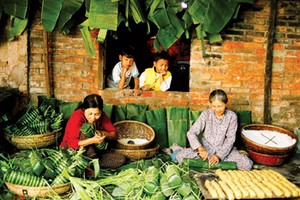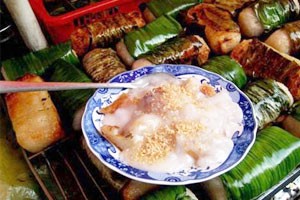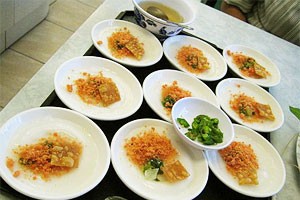In the olden days, women in the central region usually made popular traditional cakes like In, Kho Me and To on occasion of every Tet Festival, to worship their ancestors and serve to their guests.
These once very popular specialties have gradually become forgotten treats in many a family home as modern day life gets busier and people prefer to buy readymade cakes from the market.
Phuc Linh or In Cake

People in Hue City usually grow arrowroot (maranta arundinacea) as an ornamental plant in their garden. This plant has thin and long tubers covered with scales.
Tubers are peeled and ground then mixed with freshwater, and the residue of white milk like liquid is squeezed out.
This liquid is collected then mixed with water, excess water drained, and the process repeated two to three times to finally end up as a smooth and white powdery paste.
This paste is dried on a clean cloth under the sun to become a very healthy and digestible food.
To make In Cake, one kilogram of powder is sifted and exposed to dew to make it soft before being steamed and blended with 600 grams of sugar syrup.
Afterwards, the dough is poured into moulds to make 100 small cakes. The cakes are baked then wrapped, after they turn cold, in colorful pieces of paper made from shining nylon.
One should eat them in small bites and savor them in the mouth until they gradually melt on the palate, to leave a sweet and scented flavor of arrowroot.
Kho Me Cake (Sesame Cake)

Formerly, housewives in Quang Nam Province usually made cereal powder for their husbands when they went on long journeys to undertake the mandarin examinations in Hue City. This food was very light and easy to prepare.
At that time, a woman in Quy Hoa Village in Da Nang City had an idea to make the cereal powder into sesame cake for her husband before he set off for the exam.
The husband was successful and returned to his hometown to take the position of a county chief. He honored his wife’s support towards his career by treating his guests with the same sesame cake.
The cake was named Bay Lua (Seven Fires), meaning it must be baked seven times.
Kho Me Cake now is made from sticky rice. Rice is soaked in water to mill into flour, which is then poured into moulds and steamed. The cake is then baked three times before dipping into syrup of sugar and ginger. The final phase is to roll the cakes in sesame.
The cakes taste sweet and crispy. The more delicious the cake, the more glutinous and sugary it is. Kho Me Cake must be preserved carefully to prevent them from melting by exposure.
To Cake

According to ancient folk lore, To Cake was made by Au Co, legendary mother of the entire Vietnamese race, for her hundred children before they split into two groups to go to the mountainous northern region and one half to the southern coastal area.
The method to make To Cake is very simple, with ingredients being only glutinous rice, ginger, sesame and duong bat --brown sugar, a typical sugar of Quang Nam Province.
Glutinous rice is dried, milled to flour then mixed with duong bat that has been cooked in water and some ginger juice. The paste is poured into moulds made from bamboo and covered with banana leaves.
The wrapped cakes are then steamed mildly then sprinkled with white sesame before drying in the sun to harden.
To Cakes are not eaten immediately after they are prepared but after storing for a period of time, when they are fried and served for an occasion.
























